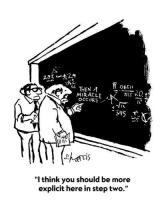
During this week’s Lunch & Learn, our colleague Anette Wenderoth shared with Universalia staff a few key messages on Theories of Change (TOC) in evaluations.
In what types of evaluations can you use a TOC? At what stage do you use it in the evaluation process? What are the questions you should raise when developing or reviewing a TOC?
Six lessons learned to keep in mind to master your TOC in evaluation:
- Evaluations that are based on an inadequate TOC can focus on the wrong things: Evaluation that is based on this inadequate ToC might only collect data on whether knowledge change has taken place and might conclude that the program is on track. It will fail to explain (at a later stage) why the envisaged behaviour change has not taken place.
- A ToC is ‘good’ if it’s useful: There are many different ways to developing a ToC, and none of them is always good or better than others. If it works for you and the client, that’s a ‘good’ ToC!
- Strive for ‘good enough’: Your ToC will never be perfect or cover every possible assumption and link. And it doesn’t have to!
- Strive for big picture: Involving clients in developing the ToC is a good idea but can lead to requests for too many details to be included. Listen and accept what is important, but also push back when ToC is at risk of getting overly complicated.
- Complement existing results frameworks: If a program/project has a results framework, reflect its main ideas and internal logic, but also go beyond e.g. by indicating logical gaps in the framework or by clarifying complex relationships/loops between elements.
- Use ‘nested’ ToCs to reflect complexity: Rather than squeezing a million details into one single ToC, consider using a high level overview TOC with more detailed ‘nested’ ToCs that can be developed separately.

